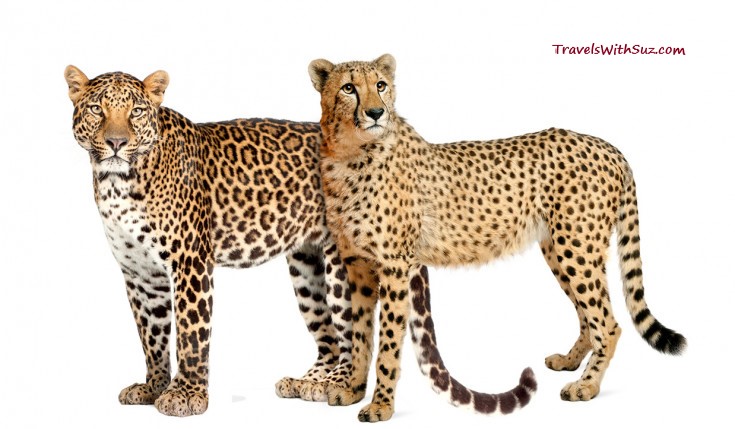
Karibu, Rafikis! (“Welcome, Friends” in Swahili)
Leopard (“Chui”) on the left
Cheetah (“Duma”) on the right
After going through my zillions of safari pics, I’ve realized that it’s not all that easy to distinguish between cheetahs and leopards in photos, so I did some research. You can see that their body types are different; leopards are powerful and muscular, while cheetahs are slender and fast. Here are many other differences (and some brilliant photos and videos!):
Stature

Cheetahs are slender, built for speed, and weigh roughly 80-110 pounds. Leopards are larger and more muscular, and use their extreme strength to drag their prey up trees.
Tear Marks on Cheetahs’ Faces
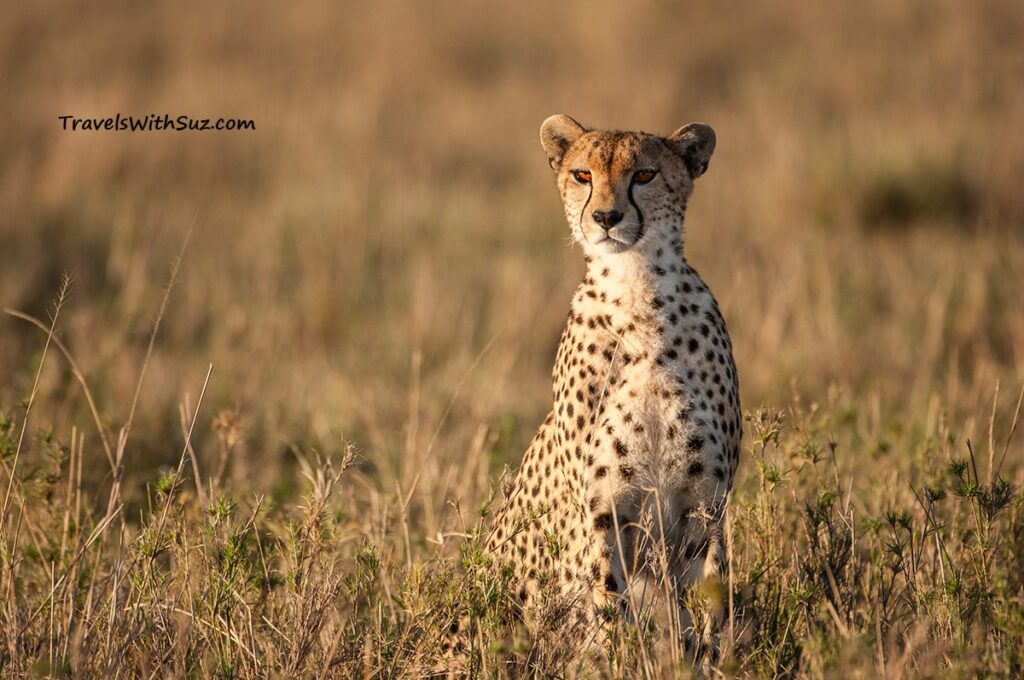
Cheetahs have black “tear marks” that go from the inner corner of their eyes, down their cheeks; they have a small, rounded head.
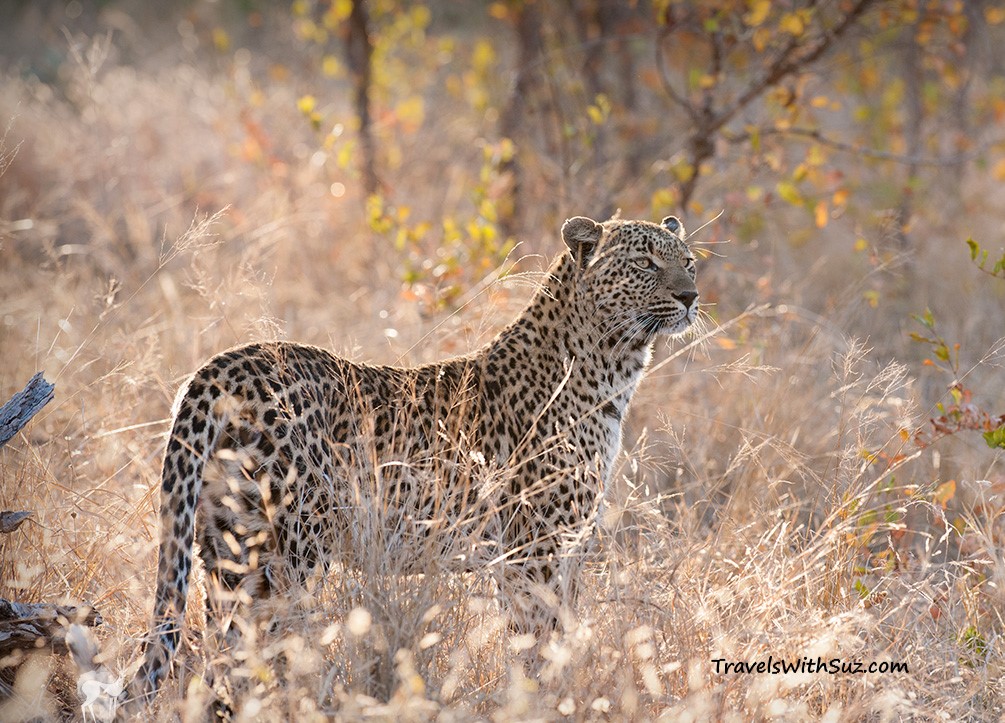
Leopards have a larger, elongated head, and do not have tear marks.
Spots
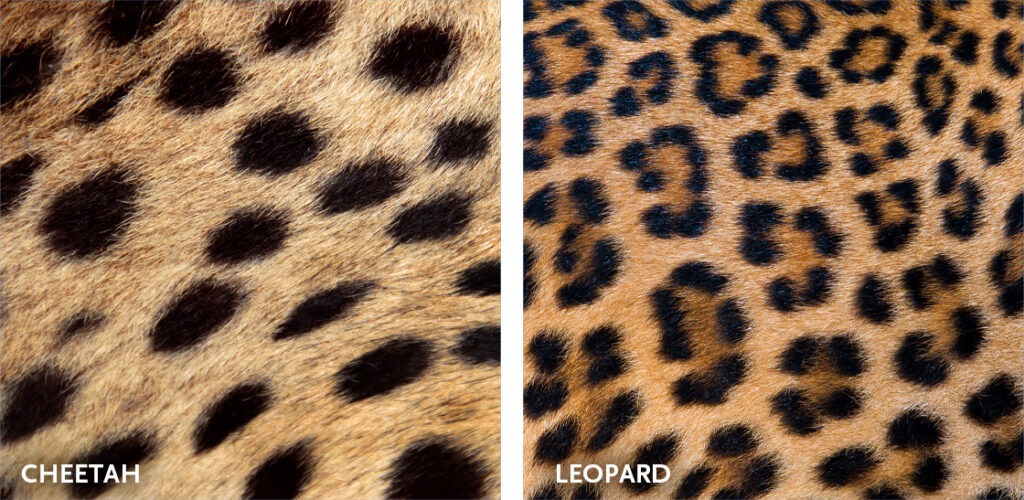
Cheetahs have round spots, while leopards have rosette-style markings. In both cases, the spots are useful as camouflage in the bush.
Behavior and Hunting Styles – Cheetahs
After a kill, cheetahs drag their prey to a secluded area to eat. They eat fast because they do not have the strength or size to fight off lions or hyenas that will try to steal their food.

The spectacle of a cheetah running at full speed is amazing; its anatomy and physique facilitate its speed and agility. Cheetahs can accelerate from 0 – 60 mph in 3 seconds, making it the fastest land animal on the planet.
The cheetah’s lightweight body, small head, and long legs are aerodynamically designed for speed. They have a flexible spine, allowing for extreme flexion while running at top speeds; the spine recoils like a spring, propelling the cheetah’s legs, and the cheetah can reach strides of up to 25 feet.
Observing the cheetah’s gait in slow motion makes the dynamics of the flexible spine easily detectable. You’ll notice that the cheetah’s gaze is unfaltering – it is locked and loaded on its prey:
Being built for speed comes at a price in the bush, though. The cheetahs’ lightweight bodies and blunt claws are no match for the strength and aggression of others predators, such as lions or leopards. If faced with having to defend itself or its kill, a cheetah will flee instead of fighting. This is one of the many factors challenging female cheetahs, who raise their cubs on their own. Only 10% of cheetah cubs survive to maturity.
Behavior and Hunting Styles – Leopards
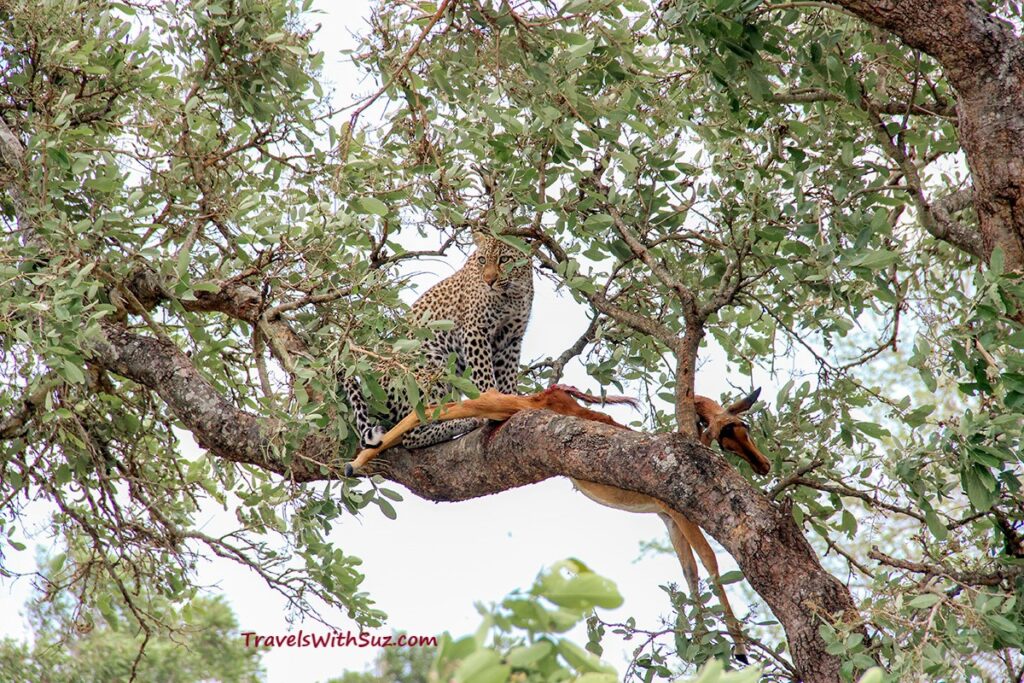
Leopards use their incredible strength to drag their kill high into tree branches, where lions and hyenas will not follow – an amazing feat of strength and coordination, when you consider that a full grown impala can weigh over 150 lbs.
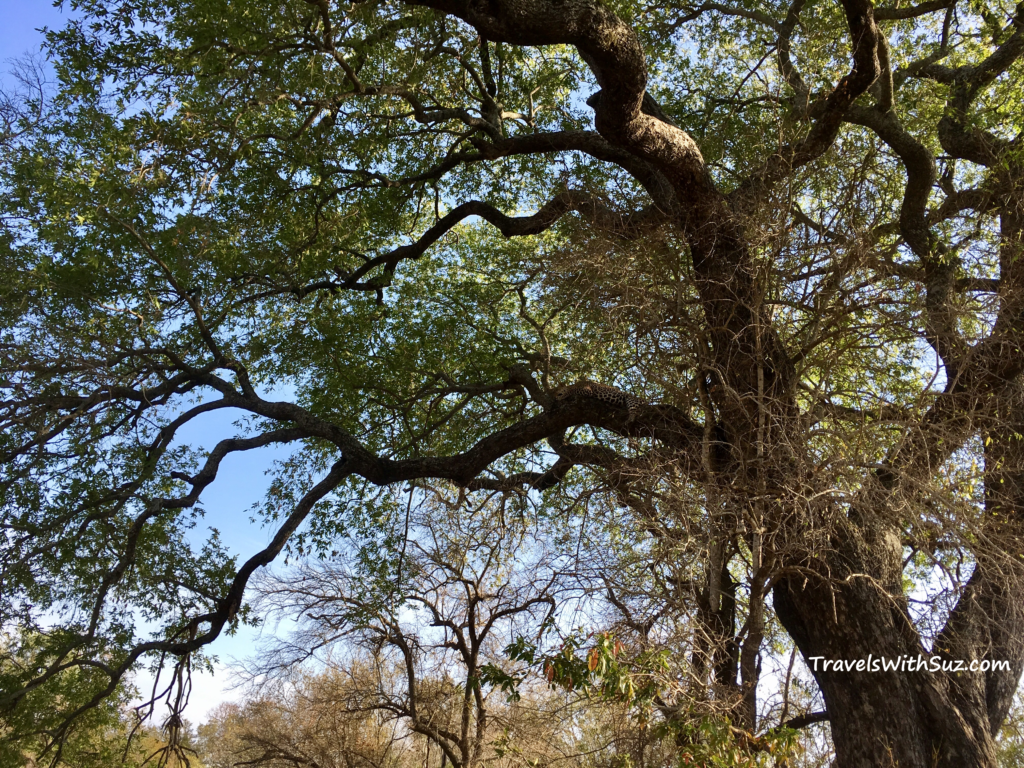
Leopards like to – literally – hang out in trees to rest. They are very well camouflaged there… can you find the leopard in this tree?
Once a leopard has made a successful kill, they must act quickly to protect it from thieving predators. The scent of the impala in the video below has likely already caught the attention of nearby predators such as lions, which are significantly larger than leopards, or a clan of hyenas, which would outnumber and overtake this solitary cat.
Vocalizations
Cheetahs purr, and make clicking sounds; leopards growl, snarl, hiss and will roar on occasion. Cheetahs are the only big cats that cannot roar.
Final Thoughts
Unlike lions, who rely on other female members of the pride to help raise their young, both cheetahs and leopards are on their own; both have to hide their cubs in thickets, kopjes (small hills), hollowed-out tree trunks, etc., and hope their little ones are still there when they return with food.

Want more info? Find more, detailed info on cheetahs or leopards – I hadn’t realized how widespread leopards are in the world.
I’m preparing some posts on my safaris; I’ve been to South Africa (at private lodges around Kruger Park), and in Tanzania – the Serengeti, and Ngorongoro Crater. Here are some cute pics of safari moms and babies.
Have you been fortunate enough to have been on a safari, and to have seen some big cats and other animals? Share your stories with me!
Did you sign up for my newsletter yet?

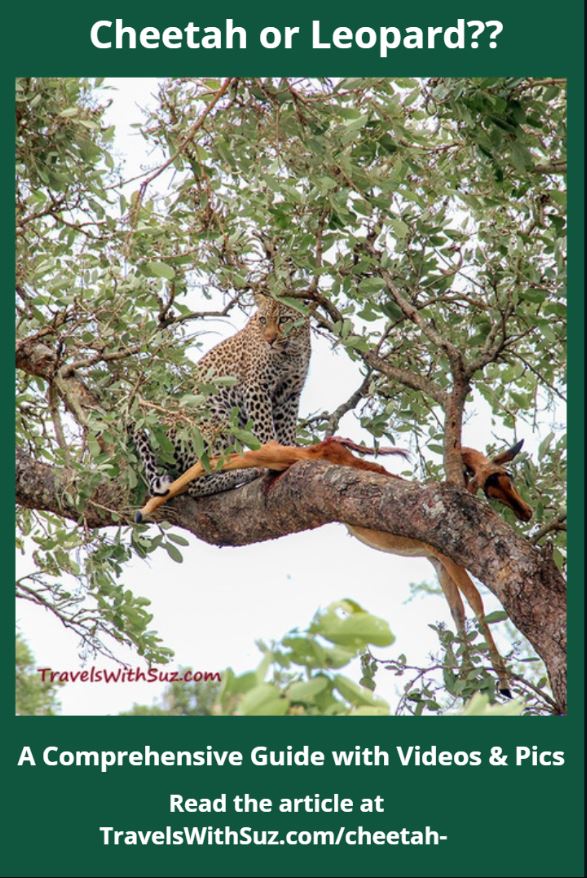

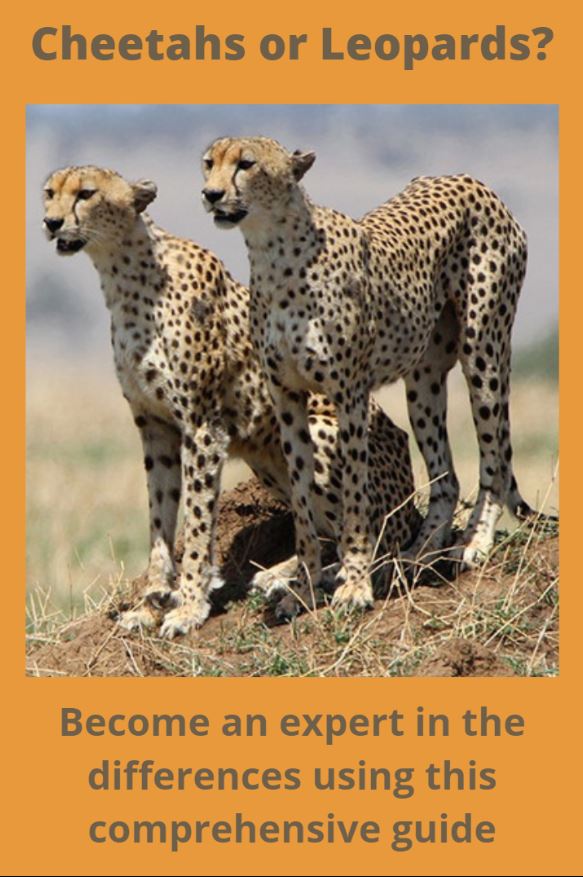
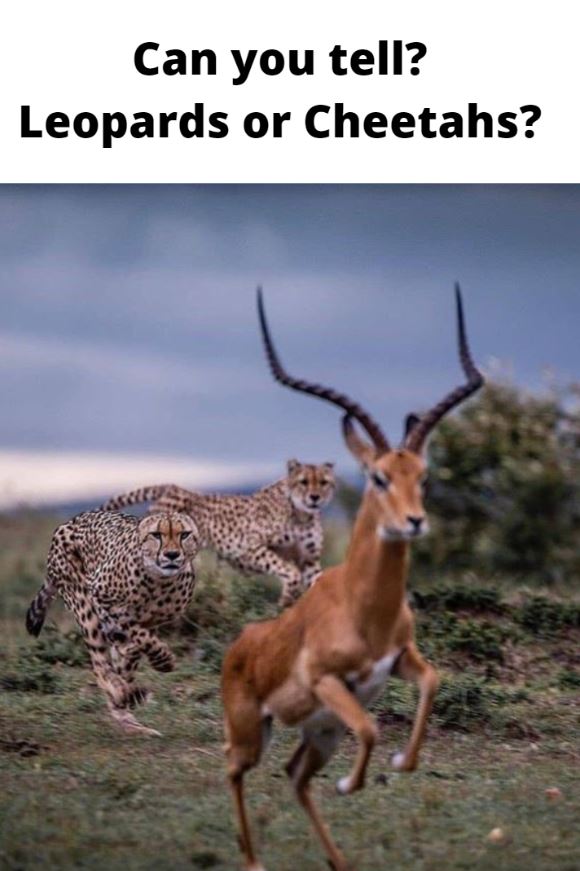

Very interesting! Showed my kids the article and they were fascinated! Someday we will make it to Africa!
This is such an incredible guide – thank you for sharing! As a South African it feels like I’ve always known the difference between the two but I can see how it can be difficult for people to distinguish between the two if they don’t go on regular safaris. I must say, I’m enamored by leopards and can spend hours watching them if I’m lucky enough to find them on a self game drive. Your last photo of the cub is absolutely stunning!
December 4 is World Cheetah Day!
Fun to see these pictures and the side-by-side comparison! I did a “cheetah encounter” while on a trip to South Africa and it was a memory I’ll never forget.
I didn’t know about the tear marks. Now when my kids ask me I will have answers to their questions! Would love to read about your time in the Serengeti!
I have soooo many travel posts to write!
This is so interesting! I never really thought about the differences. It’s amazing what traveling can teach us! This whole entire time I’ve been calling what I thought was cheetah print, cheetah print, but it’s actually leopard print. Now I am an expert in both!
Very interesting! I guess I didn’t realize how close and confusing the distinguishing between the two can be!
Yes! There are so many people who think they’re the same thing.
Thank you for the detailed differences between these two! My daughter has always loved snow leopards. At least I know what those look like!
Great post!! I didn’t know the difference between the two, but now I know. Although the cheetah clothing print looks more like a leopard print. You think?
It seems I always see the rosettes (leopard spots) when I see printed fabric…
It can be very difficult to tell the difference if you don’t know what to look for. I always have to go by the spots!
If I had to choose – Cheetah would be the one I would recognize. The tear marks really have made the distinction for me! This was a fun read!
How interesting. I don’t think I have ever even thought about the difference, I just assumed they were the same. Thank you!
Great article! I saw both of these gorgeous creatures when in the Serengeti. I love how you explain the differences between the two cats. Thanks!
Love all this, my kids liked checking out the differences between cheetahs and leopards too!